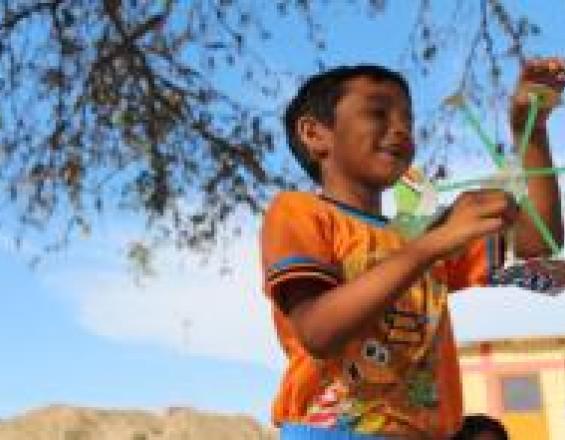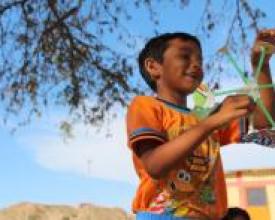ConCiencia - Conservación por amor //Guerilla Educación Ambiental
Solución completa

ConCiencia
ConCiencia
Trabajamos con la población local para estrechar lazos y vigilar la naturaleza creando campamentos de naturaleza en distintos lugares.
Incluimos actividades familiares divertidas y útiles. Niños y padres adquieren confianza para pasar tiempo en la naturaleza y explorar.
Desarrollando recursos didácticos y colaborando con las escuelas, podemos introducir poco a poco experiencias de inmersión en la naturaleza en los planes de estudio. Es importante que se produzcan cambios en la política para ampliar este tipo de enfoque educativo.
Última actualización: 02 Oct 2020
3714 Vistas
Contexto
Défis à relever
necesidad de una mayor concienciación medioambiental
Ubicación
Perú, costa
Sudamérica
Procesar
Resumen del proceso
Empezar utilizando el Diseño Centrado en el Ser Humano nos ayuda a crear programas adecuados a cada situación. Los equipos multidisciplinares nos ayudan a hacerlo aportando puntos de vista variados. Siguiendo los intereses de los estudiantes nos aseguramos de que se satisfacen los intereses de nuestro principal beneficiario y de que la educación funciona para ellos. Con una producción y entrega rápidas de estos programas, podemos evaluar su éxito y hacer los ajustes necesarios sin perder una gran inversión de tiempo y recursos.
Bloques de construcción
Diseño centrado en el ser humano
Diseño centrado en el ser humano 1) Investigación centrada en el ser humano: Recopilar información sobre la situación y el lugar, las necesidades y los deseos de la comunidad y los niños.
2) Crear: planes de lecciones e ideas de proyectos de aprendizaje in situ, con un equipo multidisciplinar.
3) Impartir nuestras ideas atentos a la reacción de los niños y modificando continuamente las lecciones para adaptarlas a los intereses de los alumnos y a las situaciones que vayan surgiendo.
Factores facilitadores
Capital humano - equipos grandes y multidisciplinares -Horizontal - todos los miembros del equipo tienen la misma voz -Inmersión total - vivir en el lugar - Escuchar e investigar - Entrar en un lugar con humildad y dispuesto a aprender -Extraer ideas clave -Preguntar por qué para llegar a las causas profundas de los comportamientos sobre los que se desea incidir Profundidad sobre el alcance - intentar conocer a las personas, especialmente en los extremos de una determinada actitud o situación.
Lección aprendida
-Deja las suposiciones en la puerta. Todos llevamos un bagaje cultural y, para ser eficaces fuera de nuestra comunidad particular, tenemos que reconocerlo.
- Escuche a todo el mundo, desde los niños hasta los líderes de la comunidad, cada uno tiene una gran riqueza de conocimientos. -No tenga miedo de cometer errores. A veces se aprende más de ellos.
-Asegúrate de que todo el equipo de diseño entiende el proceso o puede resultar confuso al carecer de una estructura clara. -Unifica tu mensaje. Muchas veces puede ser muy importante delinear el tono y el lenguaje, así como las normas y el comportamiento esperado.
Recursos
Equipos multidisciplinares
Involucrar a profesionales variados en la enseñanza. Nuestro equipo principal está respaldado por un elenco rotativo de profesionales variados y lugareños como arquitectos, fotógrafos, músicos, surfistas, pescadores y todo tipo de artistas. La variedad de puntos de vista ayuda a descubrir el diferente potencial educativo de una clase o actividad en la naturaleza.
Factores facilitadores
Un ambiente de colaboración en el que todos contribuyen atrae a profesionales con talento.
El reto de trabajar en la educación interesa a muchos grandes profesionales.
Trabajar por un objetivo común, compartir ideologías, beneficios y propiedad.
Las opciones cortas lo hacen accesible a muchos profesionales.
Liderazgo rotativo La oportunidad de pasar tiempo en la naturaleza es una gran ventaja.
Lección aprendida
El grupo debe ayudar a cada profesional a diseñar su actividad o proyecto, encontrar el potencial educativo en su especialidad o interés, definir funciones, acordar cómo estructurar el proyecto o actividad y hacer un ensayo. -Gestionar las expectativas. Todas las partes deben saber lo que ofrecen y necesitan unas de otras.
- Ensaye las actividades y explore el terreno antes de incluir a los niños.
- Mantenga una dinámica sólida realizando actividades de ocio divertidas.
-Tómese siempre tiempo para explorar y relacionarse con la naturaleza. Haga deporte, comparta risas, prepare la cena.
- Asegúrese de proporcionar información clara sobre: a) estructuras y "rituales" diarios, b) gestión de la clase, c) procedimientos de seguridad d) vocabulario y actitudes que deseamos transmitir, e) planes de clase.
Aprendizaje impulsado por los alumnos
Siga los intereses de los alumnos. Lleve a los alumnos a lugares de zonas naturales y protegidas y observe adónde les llevan sus intereses. Buscamos el potencial educativo en los aspectos que cautivan al grupo.
Factores facilitadores
- Los niños proponen el tema y podemos descubrir juntos cómo funciona. - Es útil un debate inicial y final para señalar la aplicación científica o educativa de la actividad.
- Que los niños hablen de sus observaciones puede abrir nuevos temas de descubrimiento.
Lección aprendida
-Observa las dinámicas de grupo y aprovéchalas: en la naturaleza, muchas veces los alumnos que suelen estar callados o pasan desapercibidos tienen la oportunidad de destacar por una sensibilidad particular, foméntalo.
-Los círculos de cierre al final nos dan un momento para reflexionar sobre la emoción del día y relacionarla con los conceptos.
Educación crowdsource
Crear canales para que los distintos miembros de la comunidad participen en la enseñanza compartiendo sus experiencias, guiando salidas y aportando puntos de vista.
Factores facilitadores
-Todo el mundo sabe algo interesante sobre la naturaleza y la vida. Cada alumno, cada miembro de la comunidad, cada invitado.
- Al estar fuera, los miembros de la comunidad pueden unirse fácilmente a nosotros.
-Ser acogedores y curiosos y encontrar a quienes tienen historias o perspectivas interesantes que compartir.
Lección aprendida
Ha sido muy importante para nuestro trabajo como iniciativa itinerante impartir nuestras clases en espacios públicos para ganarnos la confianza de las comunidades (muchas de ellas son muy pequeñas y no están acostumbradas a la gente de fuera). -Todo el mundo tiene algo que ofrecer si se siente inspirado para ello. Crear una atmósfera segura, en la que todos se sientan apreciados y quieran compartir. -Trata a todo el mundo con respeto.
Impactos
-90% de los estudiantes aumentaron su comprensión sobre el 70% de los conceptos ecológicos explorados a través de nuestro programa de 5 semanas.
-1 de cada 2 alumnos declaran pasar más tiempo en la naturaleza varios meses después del programa -1 de cada 5 alumnos declaran haber recogido basura en excursiones familiares varios meses después del programa -El 80% de los padres declaran un cambio de actitud medioambiental en sus hijos.
Beneficiarios
Niños (adquieren habilidades, calidad de vida y desarrollan la administración), adultos (ganan calidad de vida)
Historia
Lao Tze escribió: "Ve al pueblo. Vive con ellos. Aprende de ellos. Ámalos. Empieza con lo que saben. Construye con lo que tienen. Pero con los mejores líderes, cuando el trabajo esté hecho, la tarea cumplida, la gente dirá: "Esto lo hemos hecho nosotros" Tenemos que asegurarnos de que las puertas están abiertas para que los niños disfruten y obtengan su educación y desarrollo de la naturaleza. La investigación demuestra sistemáticamente que el tiempo en la naturaleza, especialmente en la infancia, se correlaciona con un comportamiento y unas creencias favorables a la conservación.
